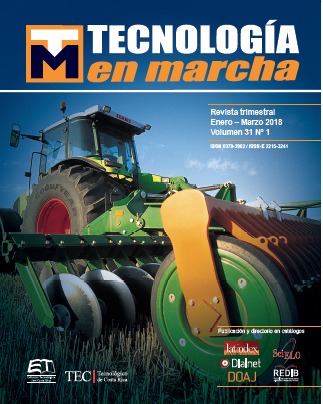Micropropagation protocol for a native bluebery from Costa Rica (Vaccinium consanguinium)
Main Article Content
Abstract
Vaccinium consanguinium, blueberry native to Costa Rica, presents nutritional and antioxidant qualities that makes it a fruit of high medicinal and nutritional value. Its adaptation to the highlands of the country places it as a species of interest, so that having techniques for obtaining clonal planting material are advisable.
The objective of this research was to continue the development of the protocol for the micropropagation of this species. The in vitroestablishment stage was validated and the use of more effective disinfectants such as the combination of enzymatic soap (5 ml.l-1) and sodium hypochlorite (3% i.a.) was included at this stage.
It was possible to establish field material in the greenhouse by sowing plants, rooting cuttings and seed germination without using any type of growth regulators, 100% survival and adaptation to environmental conditions of the greenhouse were observed. A sign of the adaptation shown by the plants harvested in the field was that 40% presented flowering and fruiting. With the aseptically established stakes, the effect of three growth regulators in 50% WPM culture medium, BA (0, 3, 5, 10, 15 and 20 mgl-1)and Z (0, 0.5 mgl-1), both cytokinin being effective at concentrations of 3 mgl-1and 0.1 mgl-1 respectively, but the best procedure for sprouting and multiplication consisted in exposing the micro-cuttings to a heat shock at 5º C for 15 days, using the same medium with 120 gl-1 of sucrose and 0.1 mgl-1 of Z. Subsequently, the materials were transferred to the liquid WPM medium supplemented with 30 gl-1 sucrose and 0.1 mgl-1 of Z with a filter paper bridge, which reduced the oxidation of the explants and improved the nutritional conditions of the culture, being reflected in higher growth and better appearance of the outbreaks.
Article Details
Los autores conservan los derechos de autor y ceden a la revista el derecho de la primera publicación y pueda editarlo, reproducirlo, distribuirlo, exhibirlo y comunicarlo en el país y en el extranjero mediante medios impresos y electrónicos. Asimismo, asumen el compromiso sobre cualquier litigio o reclamación relacionada con derechos de propiedad intelectual, exonerando de responsabilidad a la Editorial Tecnológica de Costa Rica. Además, se establece que los autores pueden realizar otros acuerdos contractuales independientes y adicionales para la distribución no exclusiva de la versión del artículo publicado en esta revista (p. ej., incluirlo en un repositorio institucional o publicarlo en un libro) siempre que indiquen claramente que el trabajo se publicó por primera vez en esta revista.

